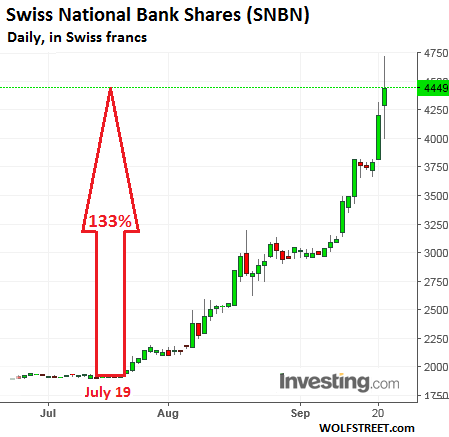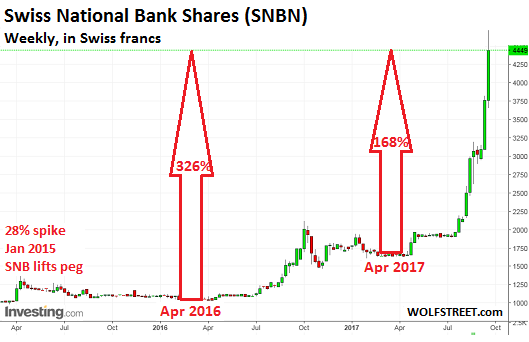But the Swiss National Bank is just an innocent bystander.
The publicly traded shares of Swiss National Bank (SNBN) rose 5.7% on Thursday and closed at a new high of 4,449 Swiss francs. They have skyrocket 133% since July 19. And that’s just the last two months of an exponential spike. Who’re the lucky ones that own the shares of the SNB?
- The Cantons: 55.9%
- Public Cantonal banks: 18.4%
- Other public institutions: 0.5%
- Private shareholders: 25.3% (100,000 shares).
With only 100,000 shares being publicly traded on thin volume, it’s easy to drive up the price. Some well-placed hype and a modest amount of buying pressure can trigger big moves that then inspire other speculators to jump in and chase the small number of shares.
From July 19 until August 21, shares jumped by 912 francs, or 48%. Then on August 22, they were hyped in an article in the German daily, Die Welt. Here are some of the nuggets:
- “The dream of every company: to make money out of nothing.”
- The SNB “seems to have found the world formula.”
- “It creates value out of nothing.”
- “The private saver can participate in the central bank.”
The article spread over the next three weeks. Other media outlets jumped on it. I mused about it on September 11. Today, it culminated with an article in the Wall Street Journal. And shares have skyrocketed another 1,620 francs since August 21, or 57% in one month.
But there is a problem with this run-up: It’s a pump-and-dump scheme perpetrated by market participants, not the SNB, which is just an innocent bystander.
This chart shows the daily moves since June:

The scheme has been going on for a while. This weekly chart shows how these shares soared 168% since April 2017 and 326% since April 2016.

The hype is this: The SNB has become a hedge fund since it decided in January 2015 to print Swiss francs — for which there is huge global demand — and buy mostly bonds and stocks denominated in euros and dollars. The idea is to put a lid on the franc by selling it.
By the end of Q2, the SNB had amassed 714.3 billion francs ($748 billion) in foreign exchange assets. This included 2,558 US-traded stocks worth $84.3 billion, with large positions in the biggest most liquid companies, including the FAANGs (Facebook, Apple, Amazon, Netflix, and Alphabet’s Google).
But here’s the thing about central banks:
They can create money out of nothing to buy assets (QE). And many of them did, including the Fed, the ECB, the Bank of Japan, the Bank of England, and the SNB.
In turn, when they sell these assets or when they let bonds mature and “roll off” the balance sheet, as the Fed will start doing on October 1, the money from those sales or redemptions gets destroyed in the reverse manner in which it was created (I explained how this works in my article on the Fed’s QE unwind).
So what benefit do SNB shareholders get?
These shareholders fall into two categories: The Confederation and cantons; and the private shareholders.
The Confederation and cantons benefit from a profit distribution agreement with the SNB. This distribution is a fixed amount, set in advance. The most recent agreement, dated November 2016, set the annual profit distribution for the years 2016 through 2020, “subject to a positive distribution reserve,” at 1 billion francs per year, which can be increased to a maximum of 2 billion francs per year.
Private shareholders just get a dividend that has been limited since day one to 15 francs a share.
So public shareholders can get up to 2 billion francs in profit distribution a year, while the 100,000 shares in private hands have to make do with 15 francs a share, or a measly 1.5 million francs (million with an M). That’s all they’ll ever get. In other words, there is no benefit from those white-hot FAANG stocks to private shareholders, ever.
The SNB agrees…
On its website, it says: “The SNB share resembles long-term bonds rather than shares (as the dividend is limited to 6% of the share capital by law).” This “share capital” is set at a nominal 250 francs per share. So that big-fat dividend is 15 francs a share, for a dividend yield of 0.3%.
The only other major central bank that can print its own money and has publicly traded shares is the Bank of Japan. It has a far bigger balance sheet, chock-full with bonds and equities, and its shares have lost 35% over the past five years.
The SNB is neither a hedge fund nor a mutual fund. It’s a central bank that creates and destroys money and sets various policy interest rates. Nearly all of the profits are channeled to government entities. The Fed too pays most of its profits to the government: For the year 2016, the Fed’s transfer to the Treasury Department came to about $92 billion.
The hype out there about all these white-hot US stocks on the SNB’s balance sheet doesn’t include the second part of the equation: That private shareholders don’t get any of it. The only hope they have is to sell the shares to a greater fool, if there are any left, hopefully.
The exponential spike of the SNB’s shares shows just how far speculators will go to chase the last dollar, euro, or franc during these crazy days of central-bank interest-rate repression, dizzying asset price inflation, serial manias, and the false certainty that all this will go on forever.
But it may not go on forever. The Fed’s QE Unwind starts October 1. The next rate hike is likely in December. Low inflation, no problem. Read… This Fed is on a Mission
Enjoy reading WOLF STREET and want to support it? You can donate. I appreciate it immensely. Click on the mug to find out how:
![]()


I wonder if the game plan is for the SNB to hold the non-CHF portfolio in perpetuity. or rather, the SNB has no other choice.
It can’t conceivably unwind its portfolio and repatriate all those USD and Euros to CHF.
And as a government entity theoretically the SNB has an infinite lifespan/time horizon.
“It creates value out of nothing.”
Sorta like Bitcoin only more transparent.
I don’t know if anybody here remembers, but this is somewhat similar to what happened to Roche AG during the 80’s (I think it was between 1984 and 1986: my memory isn’t what it used to be).
The number of publicly traded shares at the time was really small (25,000 if I remember correctly) and, just like Die Welt has gone on that absolutely ridiculous hype piece, there was a lot of unsubstantiated hype floating around that Roche was on the verge of some revolutionary medical breakthrough: anything from a replacement to sulfa drugs to miracle cancer cures was being hyped, with the result Roche AG shares hit the dizzying heights of ChF 500! Remember: this was the mid 80’s.
Then reality slowly set in and share diluition took place. Right now Roche AG trades at ChF 249.
Was it hype? Yes it was: as profitable as Roche AG was it was not worth all that money and my friends in Zurich have long suspected a dumping scheme by some very clever shrew who had bought those shares during the IPO and who made off like a bandit. A very rich bandit.
Speaking of wealthy shrews. I always try to keep an eye on the cars parked near the Zurich Stock Exchange when I am in the city, to get the pulse of the situation. Here’s how the situation developed:
2010-2013: Let there be light! A sea of McLaren’s and Aston-Martin’s.
2014: Aston Martin’s and McLaren’s completely gone. Mostly Mercedes-Benz and Lexus.
2015: Teslas aplenty.
2016-7: Even Teslas have disappeared, now it’s mostly BMW i3’s.
Notice the trend?
Yes, I call it a racket and Zurich IMO has an impressive leg up on TSX, believe it or not. Wall Street and London are a couple other qualified organized crime rackets for honorable mention. How they avoid stepping on each other’s toes is beyond my ability to comprehend. So what’s a regulator to do in this environment but keep his mouth shut, ride the waves and sanction it all?
Your memory is much more clear than mine, I barely recall the 80’s in comparison.
Zurich has nothing on Geneva, Lugano and Basel in that descending order. The amount of money-laundering and other suspect financial operations that go on in those three cities boggles the mind, albeit it’s a far cry from the 80’s.
This is not so much because of those “crackdowns” politicians and bureaucrats like to bamboozle their electorate with but simply because the private banks and other shady entities doing the laundering have mostly moved their operations to Eastern Asia to be closer to their new main customers.
Old faithful customers have been advised to move their accounts to the new seats of operation which guarantee far better conditions of anonymity than Helvetia and where mandates from Western law enforcement agencies are generally ignored without consequences.
As Kipling wrote “Asia will never be civilized according to the ways of the West: she’s too old and there’s too much of her”.
Our ever-vigilant regulators and enforcers will get right on that.
/sarc
In the global currency patina, the Swissie is viewed as one of the rare ones. This gives the SNB license to crank up the magic money machine. IOW, they “win” by starting at a higher point on the mountain and debasing their money just a tad more slowly than the rest. Perpetual motion – until it isn’t.
It would make a lot more sense if Yellen was buying SNBN, and SNB was buying Yellen’s NYSE stock. You only need one party to print the money and the other indemnify it.
You don’t think the central banksters are colluding?
Is basically a game of hot potato. The one who gets stuck with the 15 francs shares in the end loses.
Central banks pay their dues on time to the BIS more often than nations treasuries pay for the security council?
By any means necessary the Fed will draw currency out of the system and call it paid in full? The velocity only picks up when the loan is made from the Fed to the DJ in Ibiza to pay cash for a farm in Ohio?
The SNB’s shares crashed 12% on Friday, the day after I published this. I swear I didn’t do it.
Don’t be so modest…you know they read your article and got scared.